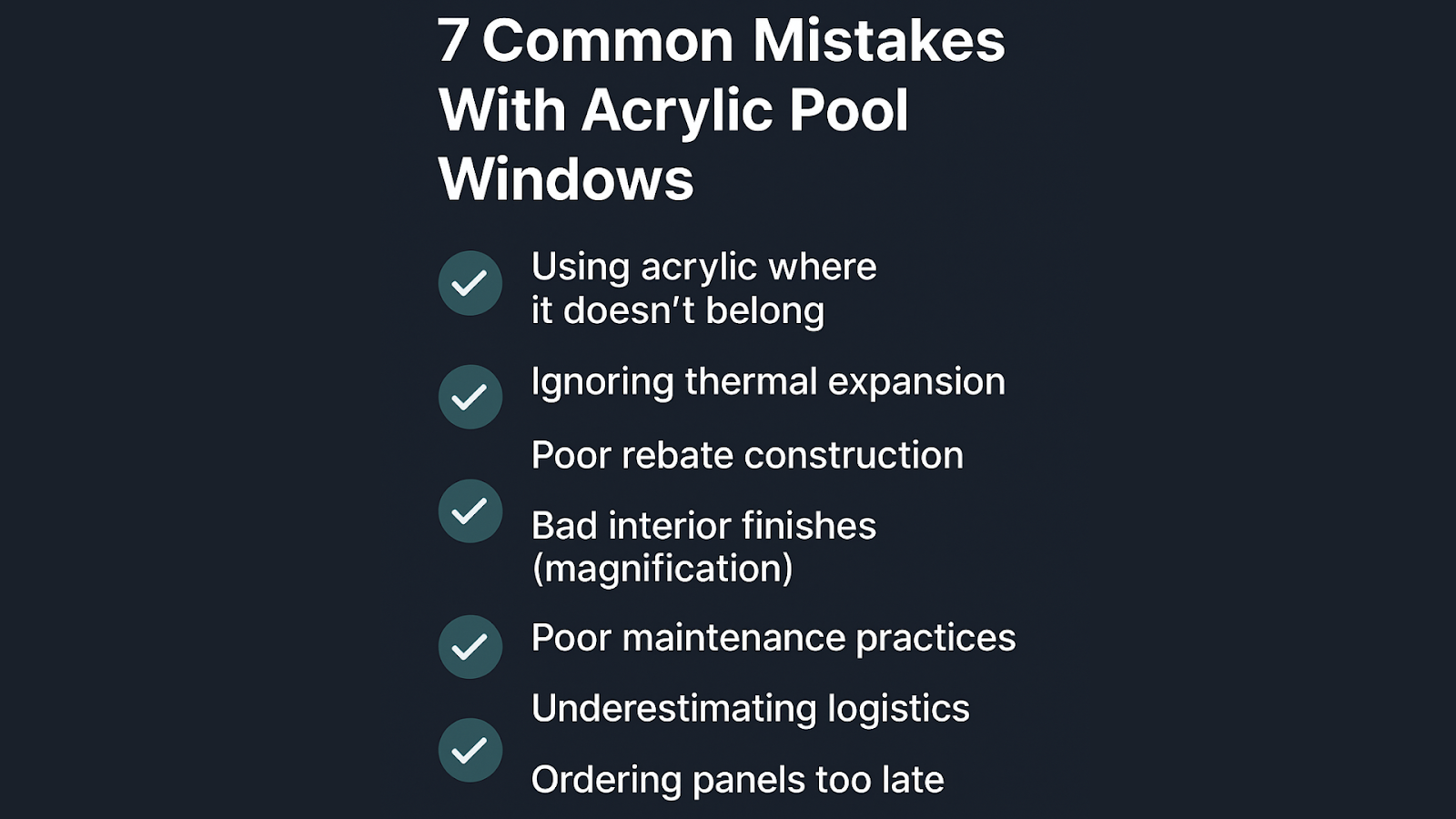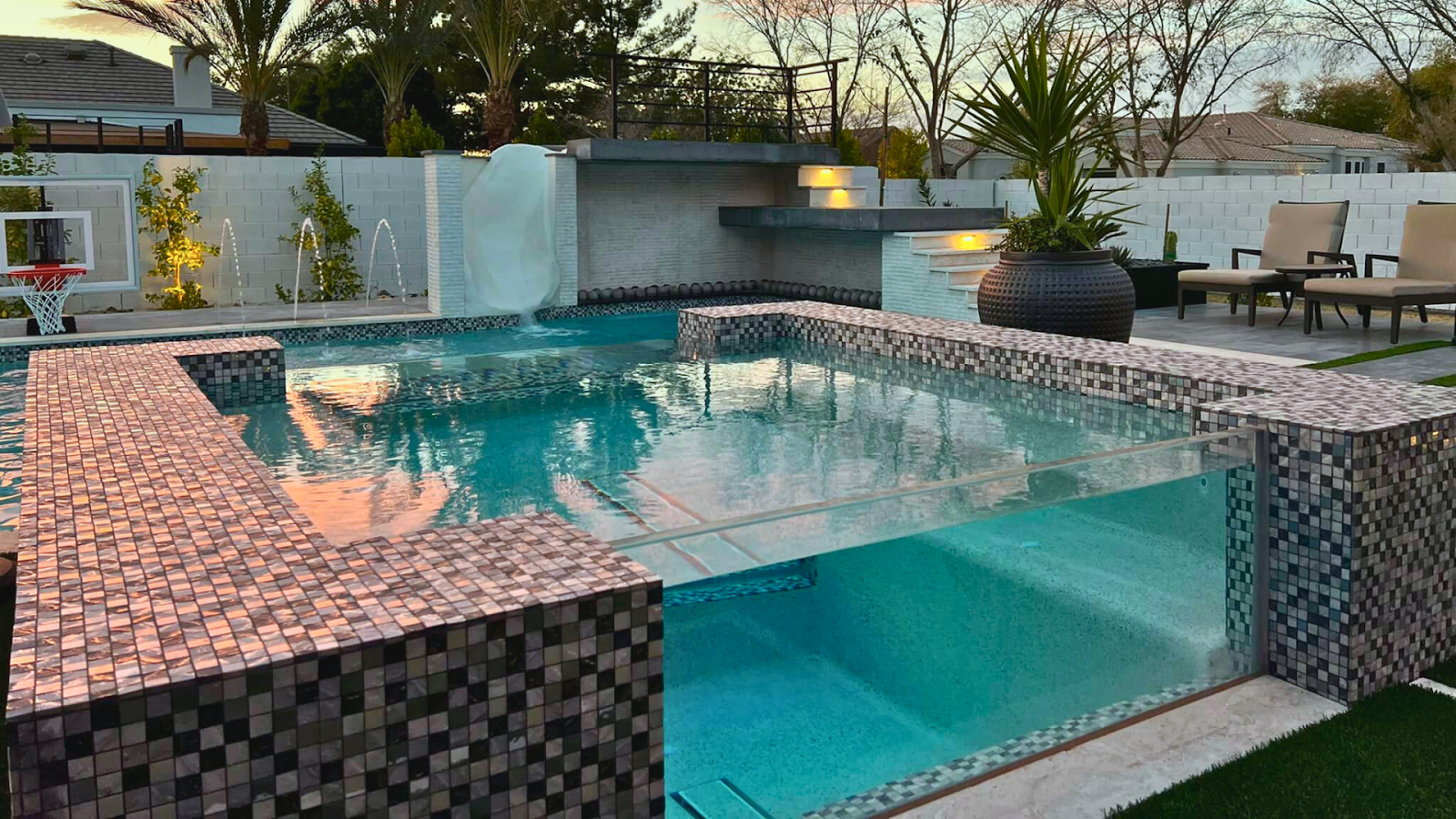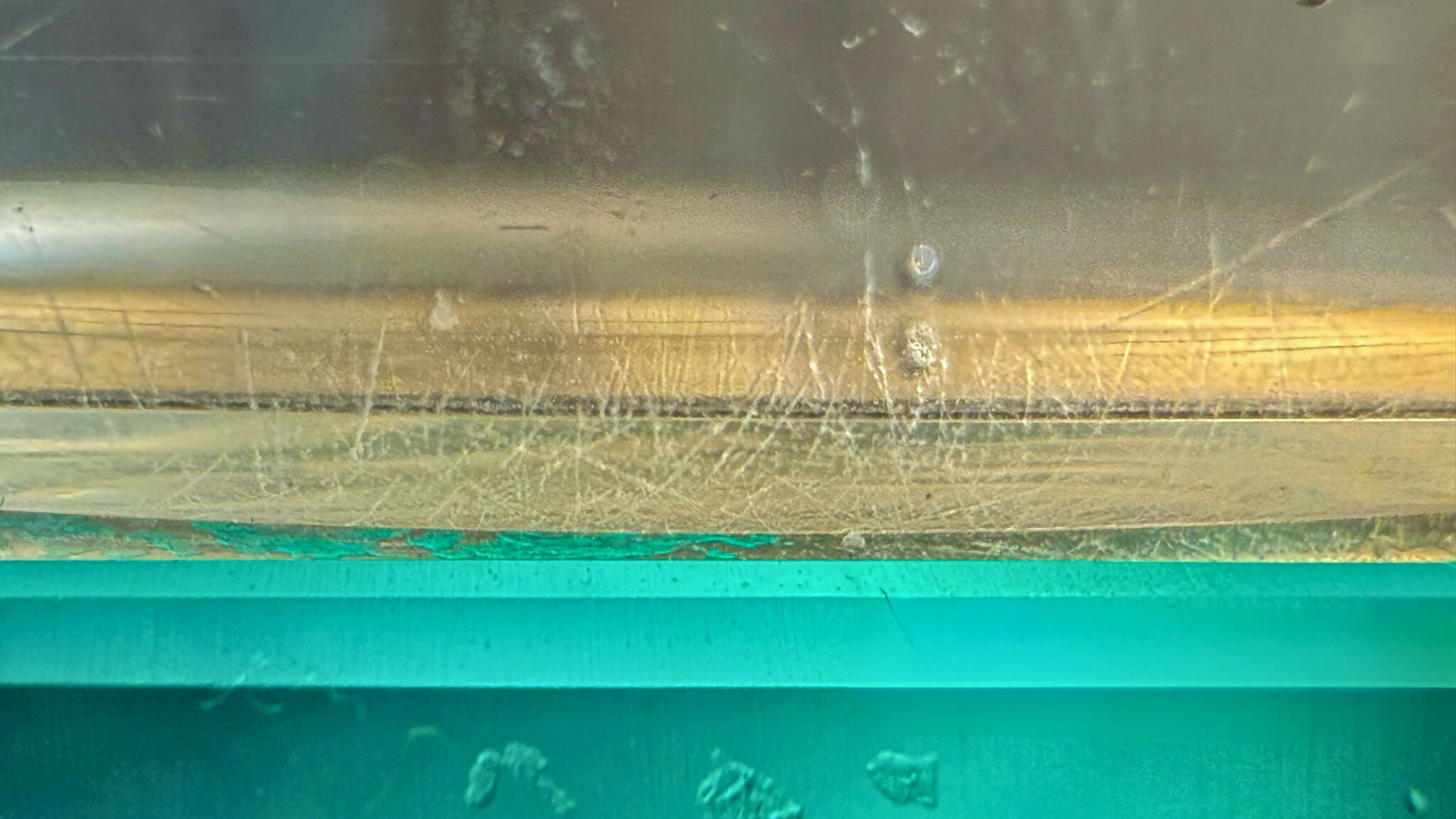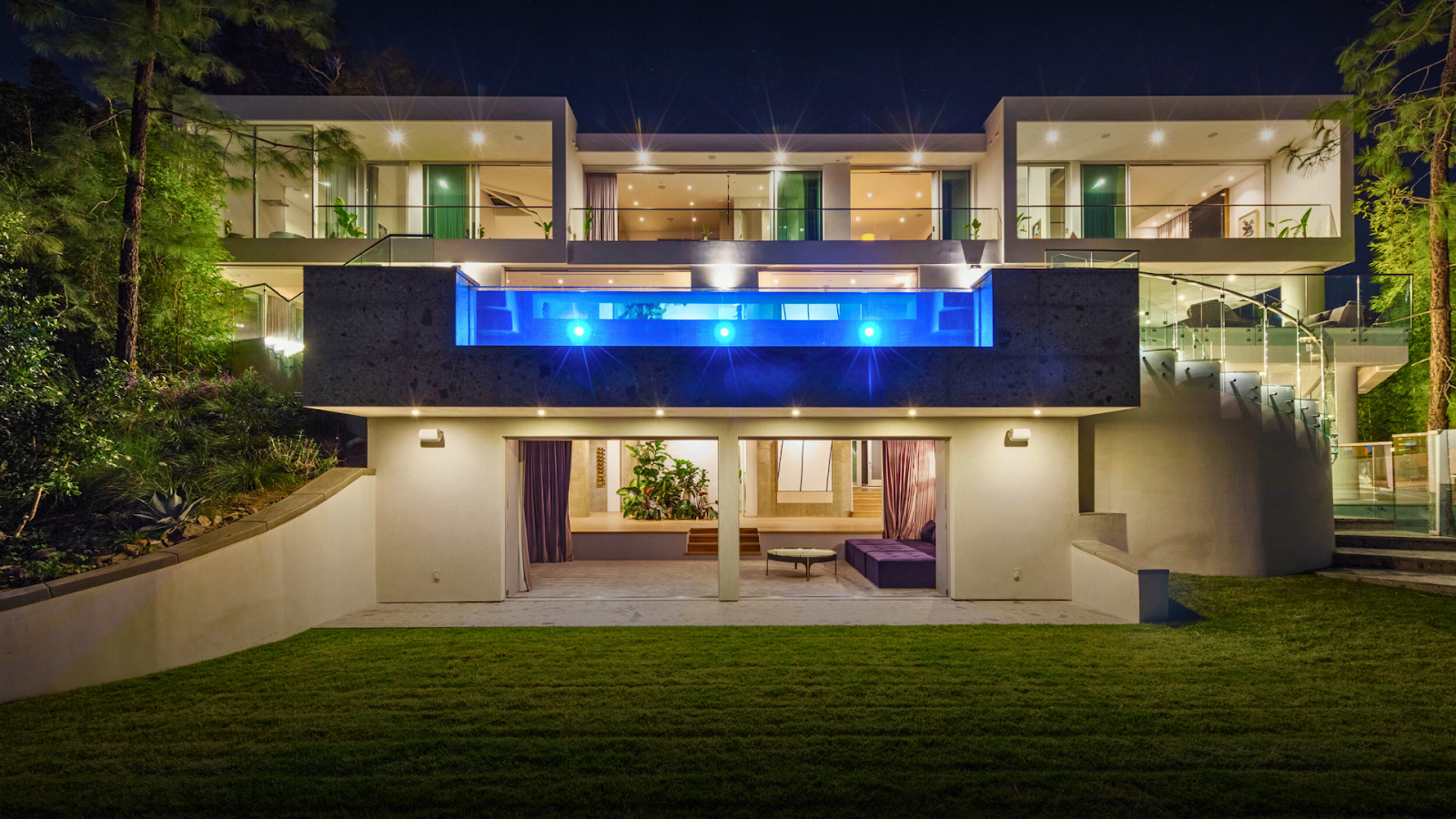7 Common Mistakes With Acrylic Pool Windows (And How to Avoid Them)


Acrylic pool windows are one of the most stunning features you can add to a pool—if you do it right. But if you don’t, they can become one of the most expensive regrets in your entire build.
I’ve been in the pool design and construction world for over two decades, and I’ve seen acrylic panels go from rare, high-end features to something almost expected in luxury builds. But here’s the truth:
> Acrylic isn’t forgiving. If you don’t plan properly, install precisely, and maintain intentionally, you’re going to run into trouble.
In this article, I will cover the top mistakes professionals make with acrylic pool windows, why they happen, and how to avoid them from day one.
You should read this with utmost seriousness, whether you are building a pool for a client or having someone build a pool for you.
Let’s begin.
TL;DR – Avoid These Pitfalls With Acrylic Pool Windows

- Don’t install acrylic just because it looks cool—use it only when the design supports it.
- Thermal expansion is real. Acrylic moves more than concrete, tile, and glass. Your rebate must be engineered for it.
- Lead times are long. Many panels take 3–6 months to fabricate and ship.
- Poor rebate construction is the #1 cause of leaks—not the panel itself.
- Acrylic windows magnify everything—bad finishes, returns, debris, and lighting flaws.
- Maintenance is specialized. Incorrect cleaning methods can permanently damage the panel.
If you are willing to hire someone to install pool windows, then work with people who have a proven track record. It’s very technical and a long-term investment. We could help you out if needed. Reach us here.
Mistake #1: Using Acrylic Where It Doesn’t Belong

Acrylic is popular, but that doesn’t mean it belongs in every pool. One of the most common errors I see is clients or designers inserting an acrylic window just because they think it’ll look cool.
Example:
If you set up a vanishing edge wall with an acrylic panel, where nobody actually views from below, it may end up reflecting like a mirror and add zero real value—only cost and complexity.
What to do instead:
Use acrylic where it actually adds to the design—like:
- Visual corridors
- Shared interior walls
- Panoramic views
- Suspended pools with public viewing angles
Mistake #2: Ignoring Thermal Expansion

Thermal expansion is one of the key factors that can only be accurately estimated by an experienced professional, and it’s a serious factor.
Acrylic expands and contracts a lot—up to 2 inches or more, depending on panel size and temperature. If your rebate (the frame that holds the panel) is too tight, that expansion will crack finishes, break seals, or compromise the panel.
And it doesn’t just expand. It yields, flexes, and shifts under load. So, a poorly calculated set up could lead to more pool issues than you can think of.
What to do instead:
- Design rebates with expansion in mind
- Use proper silicone joints and allow movement
- Avoid fusing thick panels at sharp corners (more on that below)
Mistake #3: Poor Rebate Construction

You could install the highest-quality acrylic panel in the world—and still end up with a leak if the rebate is poorly built (an amateur pool mistake to make).
Most acrylic leaks come not from the panel, but from rebates formed with voids, weak patches, or improper waterproofing. So, during pool construction, if shotcrete is applied without the right formwork or vibration in mind, it often leads to several pool issues (such as calcium nodules) popping up again and again.
What to do instead:
- Use precision formwork or saw-cut rebates post-pour
- Densify and clean rebates thoroughly
- Avoid rigid waterproofing materials that can’t flex
- Always coordinate rebate construction with panel specs
Mistake #4: Bad Interior Finishes (You’ll See Everything)

Here’s something many forget: Acrylic magnifies everything inside the pool.
Drains, fittings, grout lines—even minor imperfections become highly visible through a clear panel. That cove you thought looked smooth from the surface? It’ll look like the surface of the moon from behind an acrylic window.
So, if not done right, rather than being an attraction, it will be the reason people may hate the pool.
What to do instead:
- Tile the visible zone around the panel
- Use precision finishes—no hand-troweled plaster
- Keep returns and drains away from direct view
Mistake #5: Poor Maintenance Practices

Acrylic isn’t like tile or glass. It scratches easily. It’s sensitive to solvents. And if you don’t stay ahead of scum lines, you’ll end up polishing for days to restore clarity.
Worst mistake: letting an untrained maintenance crew scrub with the wrong brush or cleaning solution. You may end up with clouded, scratched, or chemically altered panels.
What to do instead:
- Train your service staff on proper acrylic care
- Avoid solvents and abrasive brushes
- Maintain water quality tightly to prevent buildup
- Polish panels professionally as needed
Mistake #6: Underestimating Logistics

Acrylic panels can weigh thousands of pounds. Thick acrylic doesn’t bend (like you hear with thin acrylic walls). They don’t like to be moved. And you don’t want to install them more than once.
Poor access, wrong equipment, or inadequate planning can turn an elegant install into a logistical nightmare.
What to do instead:
- Plan access routes during early design stages
- Coordinate cranes and rigging well ahead
- Use experienced installers only
- Lower panels with water levels and micrometer precision
Mistake #7: Ordering Panels Too Late
Unlike tile or decking, you can’t just order an acrylic panel on a whim. Most panels are custom-built and can take 3–6 months to produce and ship, especially for large projects or offshore manufacturing.
And quality matters. Low-end panels (especially from unknown vendors overseas) are prone to:
- Yellowing
- Surface cracking
- UV degradation
- Bad optical clarity
What to do instead:
- Start working with suppliers during schematic design
- Use proven manufacturers (e.g., Reynolds Polymer)
- Order early—before excavation, if possible
Bonus: Uncanny Mistake - Lighting Misfires

You’d be amazed how often this happens: a client installs a gorgeous panel, adds bright lighting… and now the window glows like a giant LED billboard at night—visible from the street, golf course, or neighbor’s bedroom.
What to do instead:
- Consider the panel angle and external visibility
- Use indirect lighting or adjustable dimmers
- Get HOA approval for anything near public sightlines
Final Verdict: Stunning When Smart, Costly When Careless
Acrylic pool windows are breathtaking when installed and maintained correctly—and terrible when they’re not.
They require:
- Precision engineering
- Early planning
- Experienced installers
- And realistic client expectations
In short, it’s a material that doesn’t belong in every pool. But when it does, it can transform the experience from standard to spectacular.
Pro Advice: Get Help Early
If you're even considering acrylic in your next pool project, bring in a specialist early—before excavation, before final design, before mistakes are no longer noticeable.
I've seen projects fall apart simply because someone assumed acrylic worked like tile or glass; it doesn’t.
💡 And if you need help evaluating a design or choosing the right material, feel free to reach us for service and a free quote, or ask in the comments—we’ll always share insights that save you from costly missteps.
FAQ: Acrylic Pool Window Mistakes
1. Why does acrylic need expansion space in the rebate?
Acrylic expands and contracts with temperature—significantly more than concrete or glass. If there’s no room for that movement, the pressure can crack seals, damage the structure, or warp the panel.
2. Can I use the same waterproofing method I use for tile or concrete in the rebate?
No. Many traditional waterproofing products are too rigid and can fail when the acrylic panel shifts. Always use flexible, movement-tolerant waterproofing and coordinate it with your panel specs.
3. What causes cloudy or yellow acrylic panels?
Most often: poor cleaning practices, low-quality material, or long-term UV exposure without proper protection. Cheap panels or wrong chemicals will almost always lead to cloudiness over time.
4. Can I polish a scratched acrylic panel myself?
Only minor surface scratches. For deep abrasions or clouding, it’s best to hire a professional acrylic restoration service. DIY polishing can make it worse if you use the wrong grit or method.
5. Is it okay to light the panel directly from inside the pool?
It’s not ideal. Direct lighting often causes glare and ruins visibility. Use indirect lighting, recess fixtures thoughtfully, or use dimmable LEDs to maintain clarity without overpowering the panel.
Avoid costly pool mistakes with our expert guide on acrylic pool windows. Learn how to prevent common pool issues and ensure long-term clarity, safety, and performance.











